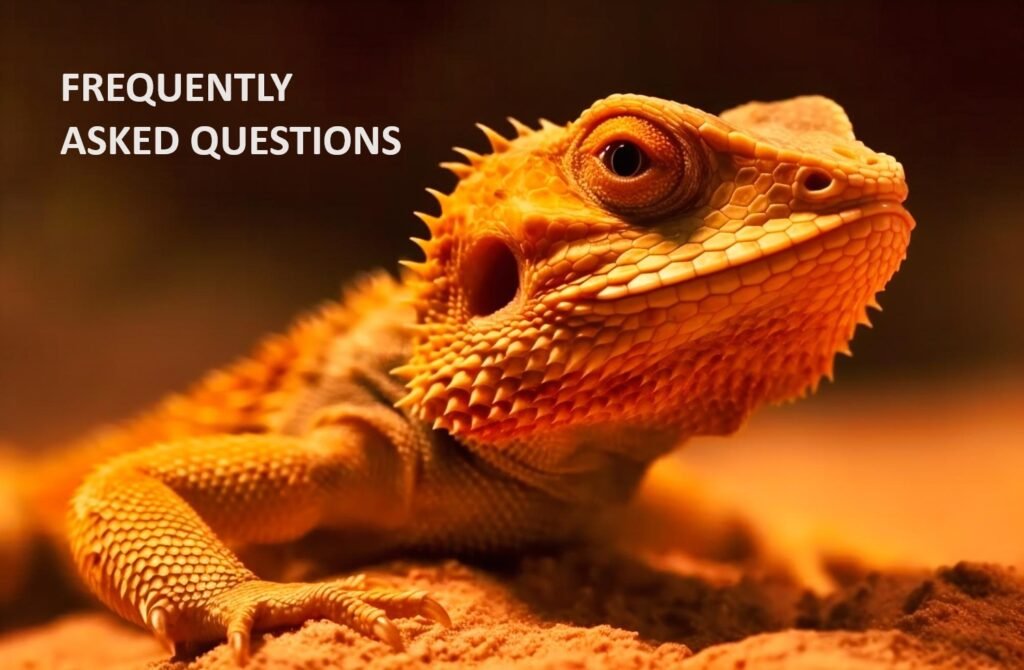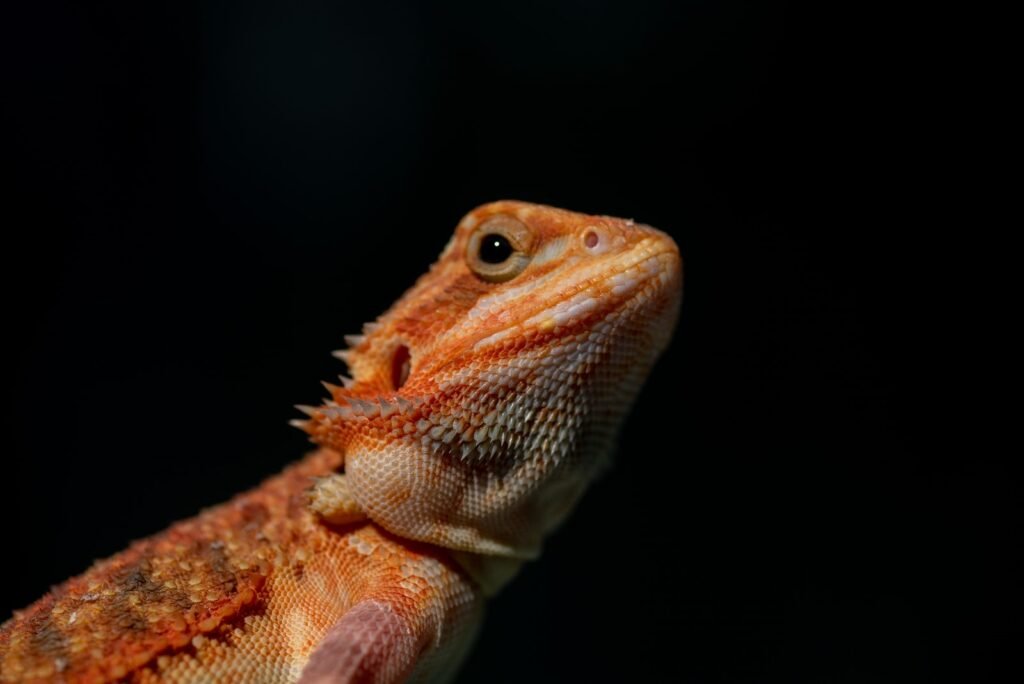Have bearded dragon questions? Our expert FAQ covers diet, setup, behavior, and all your top concerns.

Housing
❓What type of substrate is best for a bearded dragon?
✅Safety First: Avoid loose substrates (like sand) that can cause impaction if ingested.
- Recommended Options:
- Reptile carpet
- Paper towels (especially for babies)
- Non-adhesive shelf liner
- Bioactive substrates (only for advanced keepers)
❓What kind of lighting does a bearded dragon need (UVB, heat lamps)?
✅UVB Lighting: Bearded dragons need a long tube UVB light (T5 HO 10.0 strength or equivalent) covering 2/3-3/4 of the enclosure’s length. This is essential for calcium absorption and preventing metabolic bone disease.
✅Heat Lamps: Use basking lamps to create a basking spot, alongside a separate regular light bulb to provide a day/night cycle.
❓How hot should the basking spot and cool side of a bearded dragon enclosure be?
✅Basking Spot: Aim for a basking temperature between 100-110°F (38-43°C).
✅Cool Side: The cool side should stay around 75-85°F (24-29°C).
✅Thermostat: Use a thermostat to regulate basking lamp temperatures and ensure they don’t overheat.
❓How important is humidity for bearded dragons?
✅Desert Dwellers: Bearded dragons come from arid environments. Keep their humidity low, ideally between 20-40%.
✅Hydration Alternatives: Provide a shallow water dish and consider occasional misting to offer hydration opportunities.
❓Is it okay to cohabitate bearded dragons?
✅Strongly Discouraged: Cohabitation often leads to stress, injury, and even death. Even with a large enclosure, bearded dragons are territorial.
✅House Separately: For the safety and well-being of your dragons, provide each one with its own individual tank.
Diet
❓What insects are safe for bearded dragons?
✅Staple Feeders:
- Dubia roaches
- Crickets
- Locusts
- Superworms
✅Occasional Treats:
- Silkworms
- Hornworms
- Waxworms (high in fat, use sparingly)
✅Avoid:
- Mealworms (hard to digest)
- Fireflies (toxic)
- Wild-caught insects (may contain parasites)
❓How often should I feed my bearded dragon?
✅Babies (0-3 months): Feed insects 2-3 times a day, as much as they can eat in 10-15 minutes.
✅Juveniles (4-18 months): Feed insects once a day. Offer fresh vegetables daily as well.
✅Adults (18+ months): Feed insects every other day or 2-3 times a week. Offer fresh vegetables daily.
❓What vegetables and fruits can bearded dragons eat?
✅Safe Staple Veggies:
- Collard greens
- Mustard greens
- Turnip greens
- Dandelion greens
- Butternut squash
✅Occasional Greens:
- Bell peppers
- Carrots
- Green beans
✅Fruits (Treats Only!):
- Blueberries
- Apples (without peel)
- Mango
- Strawberries
❓What vegetables and fruits can bearded dragons eat?
✅Safe Staple Veggies:
- Collard greens
- Mustard greens
- Turnip greens
- Dandelion greens
- Butternut squash
✅Occasional Greens:
- Bell peppers
- Carrots
- Green beans
✅Fruits (Treats Only!):
- Blueberries
- Apples (without peel)
- Mango
- Strawberries
❓Do bearded dragons need calcium and vitamin supplements?
✅Absolutely! Dusting insects with a balanced calcium powder at most feedings is crucial to prevent metabolic bone disease.
✅Multivitamins: Offer a reptile multivitamin 2-3 times a week for additional nutritional support.
❗Important Notes:
- Age-Appropriate Amounts: Adjust portion sizes based on your bearded dragon's age and size. Avoid overfeeding, which can lead to obesity.
- Variety is Key: Offer a mix of safe vegetables and insects to create a balanced diet.
- Insect Size: Ensure insects are no larger than the space between your bearded dragon's eyes to prevent choking.
Behavior
❓Why is my bearded dragon's beard black?
✅Stress or Fear: A black beard is usually a sign of agitation. Check for environmental stressors (loud noises, other pets, enclosure setup) or potential illness.
✅Mating: Male bearded dragons will often darken their beards as part of their courtship display.
✅Temperature Regulation: Black coloration can sometimes help them absorb heat more effectively for basking.
❓Why does my bearded dragon wave its arm?
✅Submission: Bearded dragons wave one arm slowly in a circular motion to signify surrender to another beardie or a perceived threat. This often accompanies a slow head bob.
✅Exploration: Some bearded dragons might wave an arm to test air currents or investigate their surroundings.
❓Why does my bearded dragon try to dig or burrow?
✅Nesting Instincts: Female bearded dragons, especially when gravid (carrying eggs), will dig in preparation for laying. Provide a lay box with a substrate mixture if you suspect she's gravid.
✅Temperature Regulation: Digging can help them access cooler spots within the enclosure if they're too warm. Check your temperatures.
✅Brumation Attempts: If your beardie is entering brumation (dormancy), they may try to bury themselves in the substrate.
❓Why does my bearded dragon sleep in odd positions?
✅Comfort: Like many pets, beardies can sleep in positions that seem bizarre to us but are simply comfortable for them!
✅Security: Sleeping pressed against a wall or hiding spot may give them a sense of safety.
❗Important Notes:
- Context is Key: Observing your bearded dragon's overall behavior and environment helps interpret these specific actions.
- Health Concerns: If odd behavior is accompanied by lethargy, lack of appetite, or other changes, consult a reptile veterinarian.
Health
❓How many times should I bathe my bearded dragon?
✅Hydration: Bathing 1-2 times a week helps with hydration, especially during shedding. Soak them in lukewarm water (chest-deep) for 10-20 minutes.
✅Hygiene: Baths can help remove stuck-on dirt, shed skin, or fecal matter.
✅Not for Everyone: Some bearded dragons don't enjoy baths. If your dragon is stressed by bathing, misting them occasionally is an alternative.
❓What are the signs of a healthy bearded dragon?
✅Alert and Active: A healthy beardie is active during the day, basking and exploring its enclosure.
✅Clear eyes and nose: There should be no discharge or crusting.
✅Healthy Skin: Look for smooth, bright skin without wounds or signs of mites (tiny black specks).
✅Regular Poops: Their bowel movements should be well-formed and regular.
✅Good appetite: A healthy bearded dragon has a voracious appetite for both insects and greens.
❓What are some common health problems that bearded dragons can have?
✅Metabolic Bone Disease (MBD): Caused by calcium deficiency, leading to deformed bones, twitching, and paralysis.
✅Respiratory Infections: Wheezing, open-mouth breathing, and discharge indicate potential serious respiratory problems.
✅Impaction: Ingesting substrate or large food items can cause intestinal blockages.
✅Parasites: Both internal (worms) and external (mites) can affect their health.
✅Mouth Rot: Swelling, redness, and discharge around the mouth are signs of infection.
❓What should I do if I think my bearded dragon is sick?
✅Don't Delay: Observe any changes in behavior, appetite, or appearance. Seek veterinary advice promptly, as early treatment is crucial.
✅Isolation: If you have multiple reptiles, isolate the sick one to prevent others from getting ill.
✅Keep a Record: Note any symptoms and changes you've observed to help the vet with diagnosis.
❓When should I take my bearded dragon to the vet?
✅Any Significant Change: Lethargy, loss of appetite, unusual discharge, or behavior changes warrant a vet visit.
✅Annual Wellness Exams: Even if your bearded dragon seems healthy, yearly checkups with a reptile vet help catch potential problems early.
❓How do I find a qualified reptile veterinarian?
✅Specialization Matters: Look for a vet who specializes in reptiles or exotic pets. They have the necessary expertise.
✅Referrals: Ask reptile rescues, breeders, or pet stores focused on reptiles for recommendations.
✅Online Resources: Websites like the Association of Reptilian and Amphibian Veterinarians (ARAV) can help you search: https://arav.org/
❗Important Note: Bearded dragons are good at hiding illness. Being proactive with vet visits and observing your pet closely are essential!
Miscellaneous
❓How do I know if my bearded dragon is male or female?
✅Bulges: Adult males develop two distinct bulges at the base of their tail, known as hemipenal bulges. Females have a single smaller bulge in the center.
✅Femoral Pores: Males typically have larger, more pronounced femoral pores (under their thighs) than females.
✅Size Difference: Often, but not always, males grow slightly larger than females.
✅Expert Help: If unsure, reptile shops or a veterinarian specializing in reptiles can help with sexing.
❓Should I get one bearded dragon or two?
✅Strongly Recommended: Keeping bearded dragons solitary is best for their health and well-being. They are territorial and cohabitation leads to stress, injuries, or even death.
✅Companionship: Provide enrichment through handling, interaction, and a stimulating enclosure to keep your solo bearded dragon happy and content.
❓How much do bearded dragons cost?
✅Initial Cost: The cost of the bearded dragon itself can range from $50 to several hundred dollars depending on the breeder, the dragon's morph (coloration), and age.
✅Setup Costs: The initial investment in a proper enclosure, lighting, heating, etc. can easily be several hundred dollars.
✅Ongoing Expenses: Factor in food, supplements, substrate, vet visits, and electricity costs.
❓Where can I find a reputable source to buy a bearded dragon?
✅Reptile Breeder: Research well-reviewed breeders specializing in bearded dragons. Look for those who prioritize health and good genetics.
✅Reptile Shows: Reptile expos are a chance to see dragons from various breeders and potentially get them at better prices than pet stores.
✅Reptile Rescues: Consider adopting a bearded dragon in need of a loving home.
✅Avoid: Buying from chain pet stores, as these dragons may have underlying health issues or have experienced improper care.
❗Important Note: Always research a seller's reputation thoroughly before purchasing a bearded dragon.
Found Your Perfect Bearded Dragon Care Regimen? Now it’s time to find the perfect dragon! Dive into our guide: “Choosing the Right Bearded Dragon: A Comprehensive Guide” to ensure a smooth and happy adoption.



